HMS Sheffield D80
HMS Sheffield was a Type 42 guided missile destroyer, the first of fourteen Type 42 destroyers to enter the Royal Navy service plus two that, ironically entered Argentinian Navy. The ship was commissoned in February 1975 and spent its early years testing new surface-to-air Sea Dart missile system in conjuction with the radar and electronic warfare systems. Shiny Sheff as it was affectionally called became operational in 1980, but still lacked the Electronic Countermeasure jammers. In 1981, the ship participated in a couple of naval exercises and later in the year set sail for patrols in Indian Ocean and Persian Gulf. Perhaps one of the decisive moments in its short history was change of command, when in late January 1982 Captain James Salt took over and coming from submarines, had little knowledge of surface tactics and air defense mission. In March, the ship was taking part in the Atlantic Ocean exercise, last before the Falklands deployment.
On 2nd April 1982 she sailed South as a part of the Task Force to retake Falkland islands. The ship started its mission in the Total Exclusion Zone around the islands on 1st May along with other ships of the Task Force 317, Type 21 and 22 frigates and other Type 42 destroyers with a mission to ensure air and sea supremacy over the islands in preparations for the amphibious landings.
While Salt, with his submarine experience, saw greater threat in Argentinian German-built diesel submarines and adjusted the tacticts to it, as it would soon turn out, the greatest threat were Argentinian Super Etendard jets and the fearsome AM.39 Exocet antishipping missiles. In the weeks prior to arrival of RN Task Force, Argentinian pilots had plenty of time to test various attacks against their own Type 42 destroyers and discovered a blind spot in the ships radar coverage which they intended to use with great efficiency against Royal Navy's ships.
On the morning of 4th May 1982, Argentinian patrol Neptune aircraft spotted Sheffield and relayed information to the headquarters. Soon after, a pair of Super Etendards was scrambled and vectored on the British ships by the Neptune. Super Etendards were flying a really low attack profile (around 30m above sea) which made them a really hard target to detect by destroyer's radar. When the aircraft poped up to 37m to acquire radar lock, frigate HMS Glasgow got them on radar and issued a warning to other ships. Sheffield did acquite the aircraft on forward radar but not on aft and due to datalink being used for something else at the moment of attack, never received a warning from HMS Glasgow that they are under attack. The crew realized they were under attack only when the lookouts noticed the missile smoke trails approaching them. It is interesting that the bridge officers did not call the captain to the bridge, have not called the action stations, made no evasive actions and did not activate the defensive weapons or chaff.
While the second missile missed the destroyer, the first one hit her on the starboard side aproximately in the middle lengthwise 2.4m above the sea level creating a hole of about 1.2x3m. As a result of the damage, fire system was severly damaged making all the firefighting response an almost impossible task and as a result the ship was consumed by raging fires.
The crew of Sheffield try to fight fire with portable firefighting pumps and buckets for almost 4 hours until captain Salt issued the abandon order to the crew as there was a risk of Sea Dart missiles magazine explosion, the ship was not operationally capable and the frigates Arrow and Yarmouth, that were assisting Sheffield were exposed to additional Argentinian strikes. Most of the crew transffered to HMS Arrow and as they were leaving the stricken Sheffield, sublieutenant Carrington Wood led the crew in singing Monty Python's ‘Always Look On The Bride Side of Life'. Gotta love the British humour and resilience.
Over the next few days, RN made several inspections if anything was worth salvaging from the adrift ship and the decision was made to tow the ship to the island of South Georgia. On 10th May 1982 a combination of high seas and the flooding made Sheffield roll to the side during the tow on the edge of the Total exclusion zone and sink to the depth of 1.800m. Thus, she became the first RN ship sunk after World War II.
Of the crew of 281, 20 sailors perished in the attack with further 26 injured. Only one dead sailor was ever found and the ship is marked as a war grave and a protected place.
The Build
The Cyberhobby kit that I used dates back to the early 1990s Pit-Road kit. What has changed in all those decades is probably the inclusion of photo-etched parts but not much more.
The fit of the kit is not stellar though not terrible either. Most work went into fitting the rear end with the helicopter pad, which is a separate piece. The fit was really not good, and the shapes of the openings below the deck were off as well, so I tried to correct them as best as I could. PE parts were also quite soft and I didn't dare to use them on the masts, where rigging would go, so I used just parts of them and replaced the others by brass tubing from Albion Alloys. I guess my biggest gripe with the kit were the instructions which gave me quite some headaches and had to correct certain parts of the kit when they were already mounted. The instructions regarding the markings were also wrong so I tried to correct things as much as I could; I got a bunch of useful info from a modeller on my Facebook page, but unfortunately I was too much ahead in the build to correct everything, so I am just gonna list my findings below. If you wanna build HMS Sheffield as she appeared in the Falklands campaign, take note of the following:
– Numbers – all the number markings were removed from the ship
– Black stripe – it was painted verticaly in the middle of the ship as an ID measure (crews joked it was a sight for the Argentinian pilots to easier lineup for the attack). So if you apply the stripe, you shouldn't have any numbers on your ship or vice-versa.
– Yellow deck markings around the gun and Sea Dart – you only get yellow decals, but during the conflict, they were painted red. I applied the yellow ones and carefully overpainted them red with acryllic paint.
– Sea Dart missiles – most of the photos show them in dark red/blue combo. However I believe those are training rounds and live rounds are painted white with yellow band
– on the upper deck, just behind the bridge, there is a 50.cal machine gun and next to it is a vertical plate; on the real ship, they were swapped. Machine gun should be forward, towards the bridge and the plate at the back.
– life raft pods on the superstructure – there should be three instead of five.
– life raft pods on the hangar sides – there should be a slight gap between the rearmost and other three, allowing for easier install of that T shaped antennas.
– Union Jack flag on the bridge roof – 10x5mm is the perfect fit and was used from a generic flag decal sheet.
Model Data
Company: Cyberhobby / 7133
Scale: 1:700
Aftermarket: Union Jack decal from a generic flag decal sheet
Paints used: Mr.Paint
Camouflage: MRP-246 Light Arctic Grey, MRP-59 RLM66
Sea base: AK Interactive Water Gel Atlantic Blue, Water Gel Effects

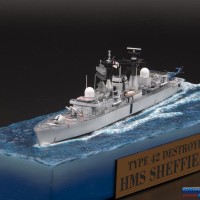
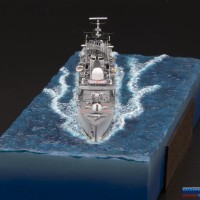
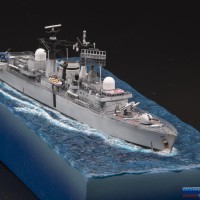
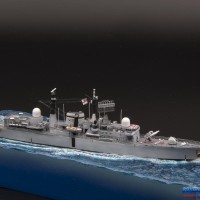
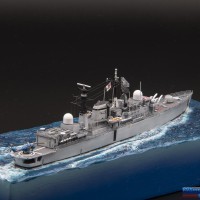
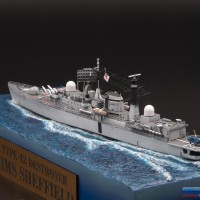
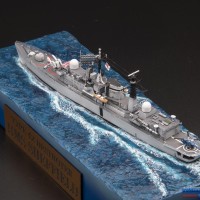
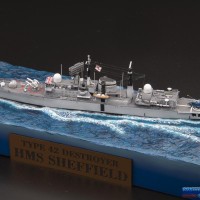
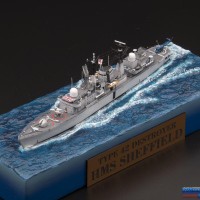
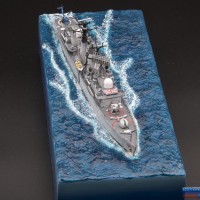
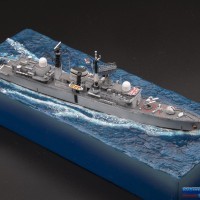
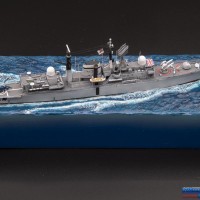
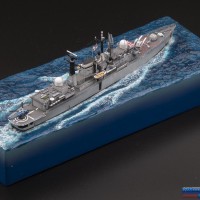
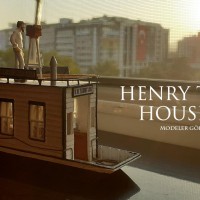
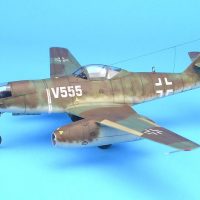
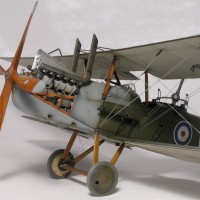
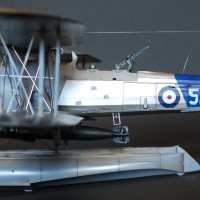
Congratulations, very nice build
Thank you, Marcello!
Congratulations, Sebastijan!
She looks wonderful, sailing during better days. A superb build!
Thanks for the detailed history and kit/build details.
Thank you very much, Spiros!
This is an amazing build, Sebastijan @inflames
The water effect is very realistic as well.
Thanks for sharing the history part.
Thank you, John. I think citing a bit of history gives "weight" to the model.
Well done, Sebastijan. Great PE work. Your excellent build is a reminder for me to start building some of my small scale ships before aging hand/eye coordination make it impossible!
Thank you, John. I actually quite struggled by PE and I am not really satisfied by some of it.
Looks great! Nice sea scape.
Thank you, Robert!
Wow impressive!
Job well done!
Thank you, Nikola!
Very nice! The water is very effective and the result is very realistic.
Thank you, Tom!